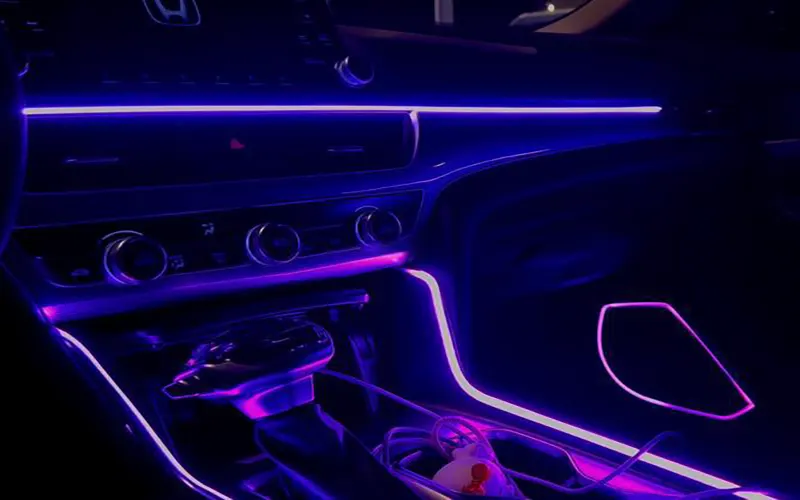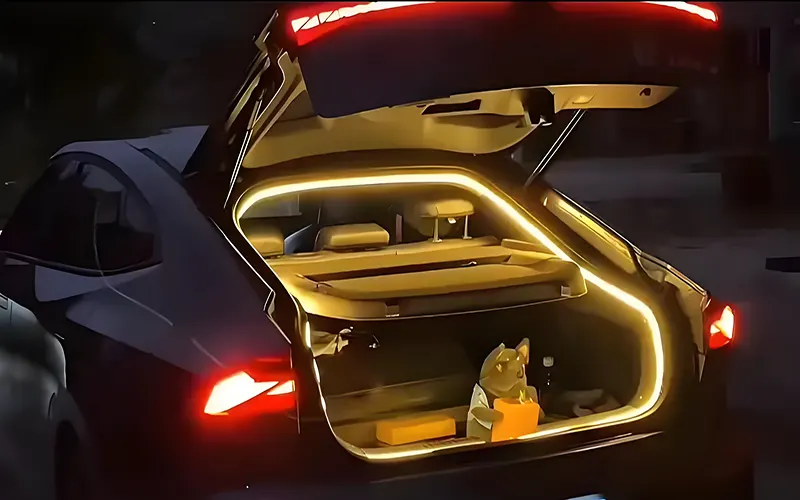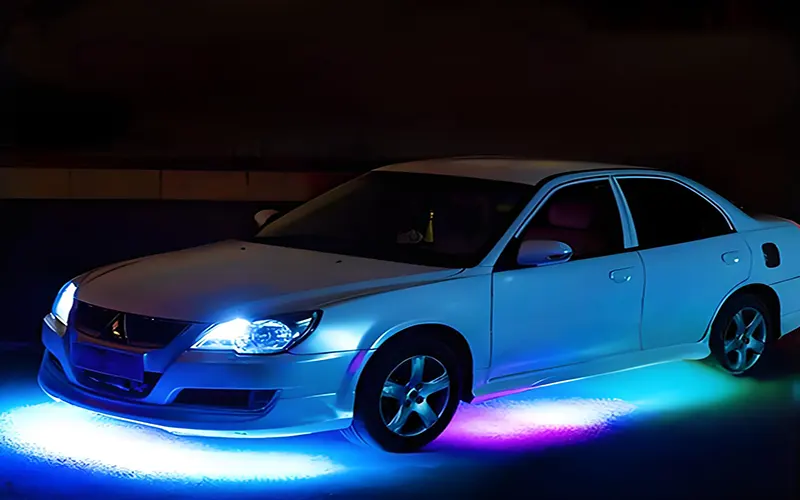In the modern automotive tuning and automotive upgrade arena, automotive LED strips have become a popular choice for enhancing a vehicle’s exterior and interior ambiance. RGB LED strips, in particular, are highly favoured by modern car owners. Whether used to improve daytime driving safety, enhance nighttime lighting, or provide subtle ambient lighting within the cabin, automotive LED strips can add a touch of technology and personalization to your vehicle.
Brightness, Color Temperature and CRI

Brightness (lumens, lm)
- Brightness determines lighting intensity and is a crucial consideration. Excessively high brightness can be glaring or distracting, while excessively low brightness can be ineffective.
- Interior ambient lighting: Choose a medium-low brightness (e.g., 600-1000 lm/m).
- Engine compartment/trunk: Choose a high brightness (≥1200 lm/m) for ease of operation. More details, pls read How to Use COB LED Light Strips for Automotive Lighting Safely and Effectively?
Color Temperature (K)
- 3000K-4000K: A warm yellow light, creating a warm and comfortable atmosphere, suitable for interior lighting.
- 6000K-6500K: A true white light, clear and bright, suitable for functional lighting (such as the engine compartment).
- RGB: Used for personalized decoration, primarily for RGB LED strips used in interiors. If you choose RGB strip, pls read A Comprehensive Guide to Wiring RGB LED Strips
CRI
CRI is often overlooked, but it is the most crucial factor in color reproduction. Which measures the ability of a light source to reproduce the true colors of an object. A CRI of 80 or higher is acceptable, and a CRI of 90 or higher is even better, especially suitable for areas requiring accurate color discrimination (such as retrieving items from the trunk).
Waterproof and Weatherproof
As we all know, most cars are exposed to wind, rain, car wash water, dust, and extreme temperatures for extended periods of time. Therefore, waterproofing and weatherproofing are crucial to the lifespan of LED strips.
- IP65: Water-resistant, suitable for areas such as undercarriage and wheel wells.
- IP67: Can withstand prolonged rain exposure, recommended for areas with long-term exposure.
- IP68: Can be used underwater for extended periods, suitable for high-demand applications.
- Additionally, when selecting automotive LED strip lights, prioritize fully encapsulated silicone products over epoxy resin finishes.
Weather resistance requirements: Operating temperature range should cover -30°C to +85°C. The housing material must have UV resistance to prevent yellowing and embrittlement after prolonged exposure to sunlight.
Automotive LED Strips: How to Connect a 12V/24V System?
In reality, automotive electrical systems are divided into 12V (passenger cars) and 24V (commercial vehicles), and the power supply must match.
Power Connection Methods:
- Directly connected to the battery: Most stable, but requires a fuse (5A-10A recommended) to protect the circuit.
- Power from the fuse box: Powered via the OBD port or a fuse splitter, no wiring required, for greater safety.
- Switch Control: Manual or linked to the door switches (e.g., for step-on lights).
Voltage Stability:
The vehicle voltage may drop to 9V during startup and can reach 14.4V during operation. It is recommended to use a voltage-stabilized driver module or a step-down constant-current power supply to prevent voltage fluctuations from damaging the LEDs.
Do Automotive LED Strips Require Professional Installation?
First, consider where the lighting is installed. This depends on the installation location and technical difficulty.
If you want to use LED strips as interior ambient lighting, for example, in the footwell or center console, this approach is easier for personal use, offers ample space, and is simple to connect. 3M adhesive backing allows for easy installation.
If you want to install LED light strips on your vehicle’s underbody lights, wheel hub lights, or engine compartment lights, the installation process is slightly more complex, requiring drilling, complex wiring, and high waterproofing requirements.
Why is Heat Dissipation Design Crucial for Automotive LED Strips?
LEDs generate heat during operation. In well-ventilated areas, this heat is negligible. However, in the enclosed, high-temperature environment of a car, poor heat dissipation can lead to serious consequences:

- Accelerated Luminous Degradation: Brightness decreases rapidly with age.
- Blackening of the LEDs: Localized overheating leads to carbonization of the encapsulating adhesive.
- Shortened Lifespan: Lifespan is halved for every 10°C increase in temperature.
Therefore, a high-quality automotive LED strip should have an aluminum substrate or metal backing to enhance thermal conductivity, and a reasonable power and lamp density. Additionally, it is essential to avoid covering or confining spaces during installation to ensure adequate air circulation.
What Factors Affect the Performance of Automotive LED Strips?
LED light strips are installed in vehicles, and their performance is closely related to the vehicle’s equipment. Therefore, if there are any problems with automotive LED light strips, we need to troubleshoot and resolve them one by one.
Unstable Voltage
A car’s electrical system doesn’t have a constant voltage output. At the moment the engine starts, the voltage can drop sharply to below 9V. While the vehicle is running, the alternator’s output voltage can reach 14.4V, far exceeding the nominal 12V. This is a common problem.
Impacts of LED light strips:
- If the voltage is too low, the light strip will fail to start or may be insufficiently bright.
- If the voltage is too high, the LED chip will be overloaded, causing accelerated light decay, blackening, or even burning.
- Voltage fluctuations can cause flickering, affecting the visual experience.
Solutions:
A voltage regulator module or DC-DC step-down constant current power supply must be used to stabilize the input voltage at the required 12V or 24V for the LED strip, avoiding the risks associated with direct battery connection.
Poor Wiring of Automotive LED Strips
We need to regularly check the connected wires, as the car is constantly in motion and some wiring is inevitably loose. Many faults are caused by loose, oxidized, or improperly crimped terminals.
Consequences:
- Excessive contact resistance causes heating at the connectors. Long-term use may melt the insulation, leading to a short circuit or fire.
- Intermittent shorting may occur, causing the light strip to flicker.
- Voltage attenuation during transmission significantly reduces brightness at the end.
Solution:
- Use heat shrink tubing to seal all connections to prevent oxidation.
- For high-current circuits, it is recommended to apply heat shrink tubing after soldering to improve reliability.
High vehicle interior temperature
LEDs are extremely sensitive to temperature. Installing light strips in high-temperature areas such as exhaust pipes, turbines, and engine blocks will significantly accelerate their aging.
Possible Consequences:
- Severe Luminous Degradation: After a few months of use, you’ll notice a noticeable decrease in brightness.
- Carbonization of the packaging material: Blackening around the LEDs affects aesthetics and heat dissipation.
- Cracked solder joints: Thermal expansion and contraction can cause circuit breakage.
Solution:
- Choose light strips with aluminum substrates or metal backing to enhance heat dissipation.
- Ensure air circulation during installation and avoid confined spaces to aid heat dissipation.
Moisture Intrusion
Cars are exposed to rain, snow, car wash water, and high humidity for extended periods. If LED strips are installed outside the vehicle and the connections are not properly waterproofed, moisture will gradually penetrate the circuitry.。

Possible consequences:
- Corrosion on the circuit board can cause solder joints to fall off or circuits to break.
- Moisture damage to the controller can lead to loss of dimming or color-changing functions.
Solution:
- All connectors must use waterproof connectors and be fitted with heat shrink tubing or waterproof adhesive.
- When installing outdoors, connectors should face downward to prevent water accumulation.
- Preferably, choose complete light strips with an IP67 rating or higher.
Poor quality LED Strip
Even if they look similar, light strips of varying quality can vary significantly. Low-quality products often use unbranded LEDs, resulting in uneven brightness across the strip, with patches of light appearing alternately bright and dim. They also experience rapid light decay, with brightness dropping by more than 50% after three months.
Therefore, it’s crucial to choose high-quality automotive LED light strips and understand the brand of the LEDs.
Frequent vibration can cause solder joints to loosen
Vibration is common during driving, especially when driving off-road or on bumpy roads. If the light strip isn’t securely fastened or the PCB is poorly crafted, prolonged vibration can cause fatigue cracking in the solder joints of the LEDs, resulting in partial dimming. Therefore, use cable ties or clips to secure the strips in the vibrating areas, avoiding relying solely on adhesive.
Conclusion
The performance of automotive LED strips is affected by multiple factors, including brightness, color temperature, waterproofing, power supply, heat dissipation, and installation environment. It is not merely a decorative element, but also an integral part of the vehicle’s electrical system. Its performance directly impacts user experience, driving safety, and legal compliance.
Contact us for professional automotive LED strips recommendations, installation guides, and customized solutions to make your car shine even at night!
FAQs
This is a common problem. Our first considerations are unstable voltage, loose wiring, or controller malfunction. We recommend checking power supply matching, wiring tightness, and using a regulated power supply.
Yes, high-quality flexible LED light strips can be bent, cut, and spliced. However, the cutting points and bend radius specified on each product should be followed to prevent damage to the circuit or LEDs.
This is often caused by different batches of LEDs, low color rendering index (CRI), or improper installation. Choosing light strips with a high CRI (CRI ≥ 90) and purchasing them in batches ensures color consistency.
LED light strips typically draw relatively little power (5-20W per strip), and under normal use, they have minimal impact on the battery. However, long-term use is not recommended, especially after the engine is turned off.
